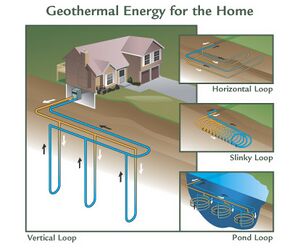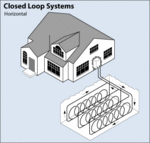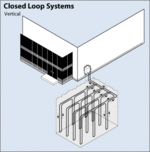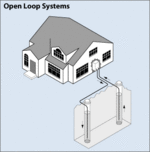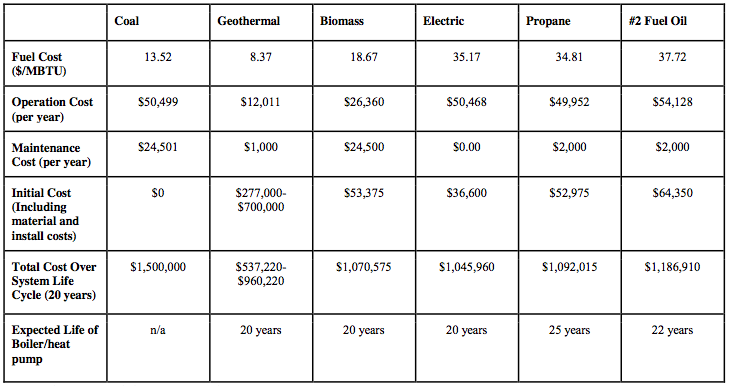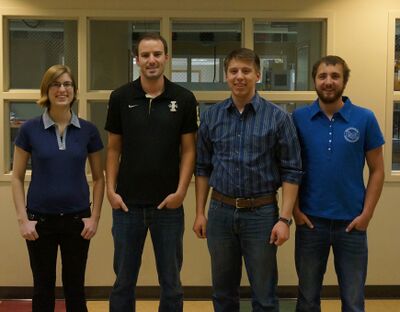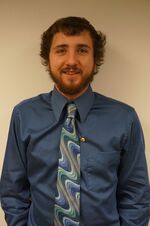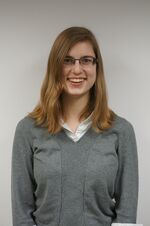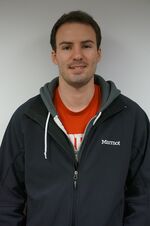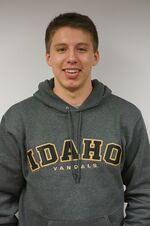Geothermal heat pump
| Variations of geothermal heat pump design | |
| Sponsors | |
| Team Name | The Entropy Police |
| Duration | Fall 2013 - Spring 2014 |
| Faculty Advisors | |
| Team Members |
|
The geothermal heat pump senior design team is tasked with designing an optimized geothermal system and cost-benefit analysis for St. Gertrude's Monastery in Cottonwood, Idaho.
Project Goals and Development
The task is to develop a program to model generalized geothermal heat pump systems using Engineering Equation Solver (EES). In addition, the completed design should include a cost-benefit analysis for geothermal (horizontal ground coupled and water storage coupled), electric steam, biomass fuel, and coal fire boiler systems. The results will be used to determine the best alternative to the existing coal fire boiler located at St. Gertrude's Monastery.
Design Goals
- Develop an EES program for generalized geothermal heat pump systems
- Validate model using existing geothermal system in the adjacent Spirit Center building
- Design a system for optimized cost and efficiency
- Determine best alternative to existing coal fire boiler using a cost-benefit analysis
Background
This project was brought to the University of Idaho Engineering Department in the fall of 2013 by the sisters of The Monastery of St. Gertrude. The sisters proposed the task of designing a system, preferably a geothermal heat pump, which would replace their existing coal fire boiler. This switch in systems was desired for a various reasons; the existing system was not very reliable, cost effective, or environmentally friendly. The sisters collectively decided that they would like a system that would meet all of these specifications, and a geothermal heat pump was chosen.
Design Specifications
- Develop geothermal heat pump system while retaining current heat delivery of hot water and steam radiators
- Heat pump system does not need to be used for cooling
- Fluid delivered to radiator must be at or in excess of 100 degrees Fahrenheit
- Building is 55000 square feet
- Yearly total heating load is about 921.7 MBtu, with maximum monthly heating loads of 261 MBtu
- The frost line in Cottonwood, Idaho is about 18 inches
- Ground temperatures are fairly constant at about 64 degrees Fahrenheit; while on site cisterns have water temperatures of 52 degrees Fahrenheit
Project Learning
Preliminary Research
Geothermal heat pumps are great alternatives for heating systems in many cases. Although they have high initial costs, they are able to operate with efficiencies in excess of one hundred percent. This generally allows for a 5-10 year payback period. Heat pumps can also work in reverse, which means that during the summer months, they can be used for cooling. They work by taking advantage of the grounds' relatively constant temperature, which is the winter, is warmer than the outside air, and in the summer is colder than the outside air. This is a fairly sustainable resource, and requires only a fraction of the energy costs of traditional systems.
Variations
| Type | Advantages | Disadvantages |
|---|---|---|
|
| |
|
| |
|
| |
|
|
Initial Interviews
Interview with Sue Tacke
- Price range:
- Less than 1 million dollars. There will be nonmonetary benefits. Environmentally friendly.
- Heating costs:
- $75000/year
- Current system: Radiator’s preferred over air-blown heaters.
- Client expectations:
- Develop options for an infrastructure for the radiators.
- First estimate was 1.2 million dollars
- Preferable that the current distribution system is the same
- What are the alternatives to coal including electricity, geothermal, etc.?
- Solar would be an option for running the geothermal system.
- Initial information
- Square footage of the main building: 55000 square feet for annex and main building
- Boiler: 75-80% efficiency
- Typically use one boiler at a time unless it is really cold. Currently satisfactory.
- In 2011, a ME and HVAC vendor looked at the building and seeing if geothermal was an option. The system specs came in at $700,000.
- Steam radiators are only in the chapel.
Economic Analysis
A cost comparison of multiple systems was requested by the client. The alternatives selected included coal, geothermal, biomass, electric, propane, and #2 fuel oil. All costs associated with each system were estimated using RS Means Mechanical Cost Data 34th edition. Fuel costs were based on the national average price per one-thousand British Thermal Unit (MBtu). Using the current coal boiler system as a bench mark, all systems were assigned a payback period based on their respective expenses and savings. Based on the client's needs and this analysis, the team decided that a geothermal heat pump would be an efficient and economically feasible replacement for the coal boiler heating system.
System Diagram
The system is modeled as three loops. The house loop is the existing delivery system installed at the Monastery consisting of radiators. The refrigeration loop is a model of the actual heat pump system. With the use of valves it allows the system to both heat and cool the building. The ground loop is heated between states 3 and 1 by a length of tubing in the ground. This utilizes the grounds constant temperature of about 64 degrees Fahrenheit.
Team Members
The Entropy Police
Mitchel Gogert
Mechanical Engineering
Hometown: Arlington, Washington
Bio: Mitchel is a senior pursuing a degree in mechanical engineering with a minor in physics. He is on track to graduate this May, when his journey into the real world will begin. He has a job at Boeing waiting for him as a manufacture engineer working on the 787 program. He is from the greater Seattle area, Arlington to be specific. Although he is here for school first, he still likes to have fun. Some of his hobbies include snowmobiling, ultimate frisbee, any sports, long walks on the beach, picking tulips, and hanging out with his fraternity brothers. Lastly, GO MARINERS!
Email: gogu9932@vandals.uidaho.edu
Desiree Reed
Mechanical Engineering
Hometown: Boise, Idaho
Bio: Desiree is a senior in mechanical engineering at the University of Idaho. She has studied all four years here. She is from Boise, ID, but grew up in Sun Valley, ID. Desiree has focused her technical electives on fluid and thermal systems. As hobbies, she does crochet and studies Japanese. She is conversationally fluent in Japanese and can read it reasonably well.
Email: reed2353@vandals.uidaho.edu
Colin Ryan
Mechanical Engineering
Hometown: Boise, Idaho
Bio: Colin is a senior studying mechanical engineering at the University of Idaho and will be graduating in the spring of 2014. Email: ryan4035@vandals.uidaho.edu
Samuel Qualls
Mechanical Engineering
Hometown: Moscow, Idaho
Bio: Samuel is graduating in May 2014 with a degree in mechanical engineering from the University of Idaho. While here, he's been an active member in the American Society of Mechanical Engineers chapter on campus as well as the Engineering Student Advisory Council. He spent a summer interning for J.E. Love Company. Last summer he helped build the curriculum for JEMS (Junior Engineering, Math and Science) summer camp at which he taught. He really enjoys hiking and playing/recording music.
Email: qual5317@vandals.uidaho.edu
